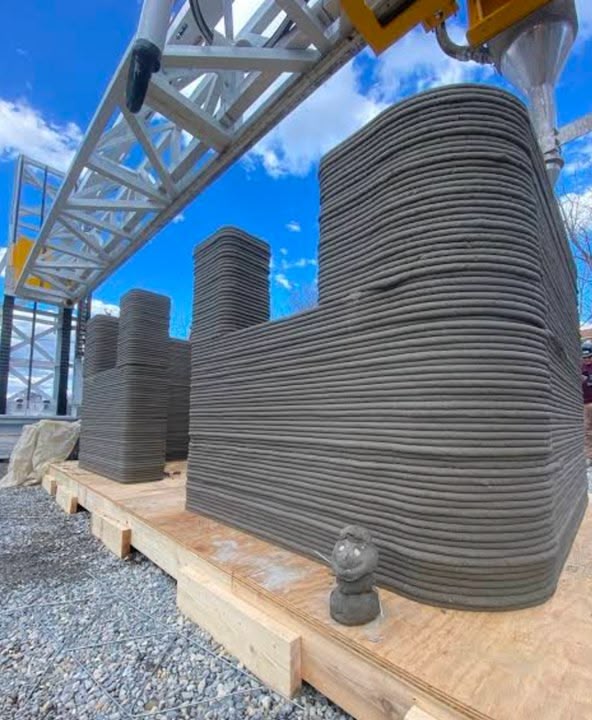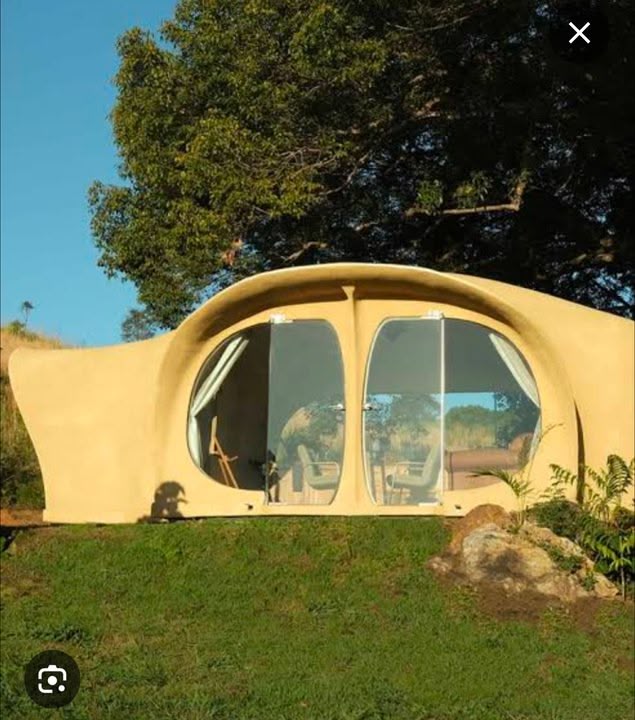jeancolby · 31-35, F
What about big Lego blocks. You could build the house in three hours, plus the kids could build it.
ArishMell · 70-79, M
@jeancolby LOL! Well, we can already buy garden sheds that come as kits of plastic panels!
Or, for those of my age, "Bayco". This model house-building system used moulded plastic "brick" panels, windows, etc. threaded onto on thin vertical steel rods plugged into appropriate holes in a perforated base. Not water-tight though....
Or, for those of my age, "Bayco". This model house-building system used moulded plastic "brick" panels, windows, etc. threaded onto on thin vertical steel rods plugged into appropriate holes in a perforated base. Not water-tight though....
OogieBoogie · F
I saw a documentary on this years ago and it was wonderful.
It changed communites, it gave them hope and helped house families and gave them a start to bettering their lives.
All it took was an idea, and someone to show it worked.
Move forward a few decades and this idea has evolved into life sized 3D houses being printed out of recycled waste products like plastic, corn husks and other creative recycled mixtures.
This could be the way of the future.
How we limit the amount of refuse we pile up and dig into the earth - instead we build homes, whole communities with it🤗
It changed communites, it gave them hope and helped house families and gave them a start to bettering their lives.
All it took was an idea, and someone to show it worked.
Move forward a few decades and this idea has evolved into life sized 3D houses being printed out of recycled waste products like plastic, corn husks and other creative recycled mixtures.
This could be the way of the future.
How we limit the amount of refuse we pile up and dig into the earth - instead we build homes, whole communities with it🤗
ArishMell · 70-79, M
Ninalanyon and others make very valid points about those bottle "bricks, beyond simply doubting their durability (which I doubt too).
There are many different types of "plastic", falling into basically two classes of synthetic material, but the word has been applied to all types making any public discussion on them, difficult.
It's important to know what the words even mean. What is "Plastic"?
A Plastic substance is a solid whose shape can be distorted, and retains that new shape. Examples include wet clay at room temperature, candle-wax at higher temperatures, and steel at incandescent heat (hundreds of degrees Celsius).
[i]"Plastic" synthetic materials fall into two main classes:[/i]
Thermosetting Plastics. Mainly the synthetic resins used alone or mixed with an inert filler, forming a viscous liquid or a plastic material that can be moulded into shape before it solidifies permanently by chemical reaction into a rigid solid. They tend to be hard, with low elasticity and no ductiliity. E.g., 'Bakelite', adhesives such as 'Araldite', and the composite materials like 'Tufnol', carbon-fibre and glass-fibre.
Thermoplastics: These soften on being heated then hold their moulded form on cooling, without chemical change (unless over-heated). Many stay soft and slightly elastic but the moulded form can be damaged permanently at quite low temperature. E.g. PV, Polyethylene, Polypropylene. They do not melt into low viscosity without starting to decompose chemically.
"Plastic" natural materials include beeswax and rubber (latex). These can be melted to sufficiently low viscosity for appropriate moulding methods. Being natural they will eventually decompose but suitable binders and preservatives indefinitely but considerably extend their lives. E.g., sulphur is added to vulcanise rubber.
Clay mixed with water is plastic then fired to create rigid, brittle ceramics. Or is mixed with limestone and fired then powdered to make cement: not plastic but rigid. Steel at room temperature is rigid but elastic (varying by type and treatment); but is forged in a plastic state (heated to glowing bright orange).
Common Uses and Re-uses:
Thermosetting plastics: adhesives, electrical and heat insulators, car and boat panels, wind-turbine blades.
Can NOT be salvaged as for re-use as they are. The most that might be done with them is pulverising the scrap to create a filler for new composites using new synthetic-resin, but this might be problematical for glass-fibre and carbon-fibre.
Thermoplastics: Their many types with widely differeing natures mean overall, they are valuable in specific ways for specific uses including electrical insulation, water-pipes, building components; vehicle components; rope and textiles; bottles, toys, shopping-bags, food wrappings.
Certain types can be salvaged and pulverised into granules amenable to heat-moulding into new forms so "recycling" thwe material (not the items!); but some such "new" plastics can be chemical and physical mongrels with their own properties, and might not be especially recoverable.
Longevity
Plastic materials' lives are so heavily dependent on their individual chemistry and the conditions they meet that really, their longevity is anything from months to unknown. The synthetic-resins are stable unless exposed to strong sunlight over a long time, as sunlight's UV radiation will degrade them. Most thermoplastics behave simillarly so protectives are added where necessary, such as for uPVC building components. We cannot really know how long plastics buried or dumped in the sea, will last because they have only been around for a century!
Disposal.
The huge range of synthetic plastics and their ubiquity makes disposing of scrap plastics problematical to say the least. It is not helped by the sheer waste practised by "developed" countries demanding ever more needless or wasteful uses: toys and novelties, clothes worn once and thrown away (last week's colour, darling); "disposable" goods, "microplastic" beads in toothpaste and cleansers; tap-water sold in polyethylene bottles in regions with potable tap-water; plastic items of genuine use merely thrown in the household refuse when broken or no longer wanted. (Often including metals, as in electrical and electronic items that can and should be collected for materials-recovery.)
The natural plastics' longevity, according to processing and conditions, can be notorious as with the world's bank of umpteen millions of old tyres, made of rubber, carbon-black and "Nylon" (a thermoplastic) or steel-wire reinforcement. Some are pulverised to recover the steel and create rubber granules for artificial turf and playground surfacing.
Some of the marine plastics is from lost or discarded fishing and marine equipment. E,g, Polypropylene (a thermoplastic) is a very good rope material but decomposes fairly rapidly in sunlight to tiny flakes. Another lot are the granules added to cleansers, and some manufacturers have replaced them with natural alternatives. Most though, is pure, inexcuseable litter left or jettisoned by people too idle to take it back home for proper disposal.
Those images of people in poor countries, scraping through vast heaps of discarded plastc bottles, and laudable but desperate attempts to use them as short-term building-materials, show just how wasteful it all is.
Although using the bottles as "bricks" answers two problems at once it can only be a short-term answer and once the bottled degarde, what will happen to their fragments?
WHY are there such huge tips of the things in the first place? WHY is there so much plastic in the sea?
It is NOT the materials' fault beyond their potential but very variable longevity, and that only certain types can be salvaged..
It is the fault of people: wanting needlessly wasteful plastic products, being ignorant, lazy or downright wilful as users, but also many countries genuinely lacking proper collection systems for scrap plastics, metals, electrical and paper products.
It would be better for those countries in many ways to establish processing plants to recover and re-process those salvageable materials, rather than using mere landfills or open tips for people to scavenge from.
......
Supreme irony.....
Most of the world is slowly and painfully moving from using coal, oil-products and gas for electricity generation, initially to try to ameliorate human-wrought climate-change, but those minerals will become depleted in time anyway.
The replacements include vast wind-turbines and solar-arrays.
Both, but especially the turbines, and the associated equipment require considerable amounts of thermosetting and thermoplastic materials. The turbines, especially off-shore, also need large volumes of lubricants, hydraulic oils and high-grade paints - the last are types of synthetic-resin.
The raw chemicals for these materials and almost all synthetic plastics, are derived from Petroleum. The finite mineral, a.k.a. Crude Oil, that many of the Green types think only a "fossil-fuel".
There are many different types of "plastic", falling into basically two classes of synthetic material, but the word has been applied to all types making any public discussion on them, difficult.
It's important to know what the words even mean. What is "Plastic"?
A Plastic substance is a solid whose shape can be distorted, and retains that new shape. Examples include wet clay at room temperature, candle-wax at higher temperatures, and steel at incandescent heat (hundreds of degrees Celsius).
[i]"Plastic" synthetic materials fall into two main classes:[/i]
Thermosetting Plastics. Mainly the synthetic resins used alone or mixed with an inert filler, forming a viscous liquid or a plastic material that can be moulded into shape before it solidifies permanently by chemical reaction into a rigid solid. They tend to be hard, with low elasticity and no ductiliity. E.g., 'Bakelite', adhesives such as 'Araldite', and the composite materials like 'Tufnol', carbon-fibre and glass-fibre.
Thermoplastics: These soften on being heated then hold their moulded form on cooling, without chemical change (unless over-heated). Many stay soft and slightly elastic but the moulded form can be damaged permanently at quite low temperature. E.g. PV, Polyethylene, Polypropylene. They do not melt into low viscosity without starting to decompose chemically.
"Plastic" natural materials include beeswax and rubber (latex). These can be melted to sufficiently low viscosity for appropriate moulding methods. Being natural they will eventually decompose but suitable binders and preservatives indefinitely but considerably extend their lives. E.g., sulphur is added to vulcanise rubber.
Clay mixed with water is plastic then fired to create rigid, brittle ceramics. Or is mixed with limestone and fired then powdered to make cement: not plastic but rigid. Steel at room temperature is rigid but elastic (varying by type and treatment); but is forged in a plastic state (heated to glowing bright orange).
Common Uses and Re-uses:
Thermosetting plastics: adhesives, electrical and heat insulators, car and boat panels, wind-turbine blades.
Can NOT be salvaged as for re-use as they are. The most that might be done with them is pulverising the scrap to create a filler for new composites using new synthetic-resin, but this might be problematical for glass-fibre and carbon-fibre.
Thermoplastics: Their many types with widely differeing natures mean overall, they are valuable in specific ways for specific uses including electrical insulation, water-pipes, building components; vehicle components; rope and textiles; bottles, toys, shopping-bags, food wrappings.
Certain types can be salvaged and pulverised into granules amenable to heat-moulding into new forms so "recycling" thwe material (not the items!); but some such "new" plastics can be chemical and physical mongrels with their own properties, and might not be especially recoverable.
Longevity
Plastic materials' lives are so heavily dependent on their individual chemistry and the conditions they meet that really, their longevity is anything from months to unknown. The synthetic-resins are stable unless exposed to strong sunlight over a long time, as sunlight's UV radiation will degrade them. Most thermoplastics behave simillarly so protectives are added where necessary, such as for uPVC building components. We cannot really know how long plastics buried or dumped in the sea, will last because they have only been around for a century!
Disposal.
The huge range of synthetic plastics and their ubiquity makes disposing of scrap plastics problematical to say the least. It is not helped by the sheer waste practised by "developed" countries demanding ever more needless or wasteful uses: toys and novelties, clothes worn once and thrown away (last week's colour, darling); "disposable" goods, "microplastic" beads in toothpaste and cleansers; tap-water sold in polyethylene bottles in regions with potable tap-water; plastic items of genuine use merely thrown in the household refuse when broken or no longer wanted. (Often including metals, as in electrical and electronic items that can and should be collected for materials-recovery.)
The natural plastics' longevity, according to processing and conditions, can be notorious as with the world's bank of umpteen millions of old tyres, made of rubber, carbon-black and "Nylon" (a thermoplastic) or steel-wire reinforcement. Some are pulverised to recover the steel and create rubber granules for artificial turf and playground surfacing.
Some of the marine plastics is from lost or discarded fishing and marine equipment. E,g, Polypropylene (a thermoplastic) is a very good rope material but decomposes fairly rapidly in sunlight to tiny flakes. Another lot are the granules added to cleansers, and some manufacturers have replaced them with natural alternatives. Most though, is pure, inexcuseable litter left or jettisoned by people too idle to take it back home for proper disposal.
Those images of people in poor countries, scraping through vast heaps of discarded plastc bottles, and laudable but desperate attempts to use them as short-term building-materials, show just how wasteful it all is.
Although using the bottles as "bricks" answers two problems at once it can only be a short-term answer and once the bottled degarde, what will happen to their fragments?
WHY are there such huge tips of the things in the first place? WHY is there so much plastic in the sea?
It is NOT the materials' fault beyond their potential but very variable longevity, and that only certain types can be salvaged..
It is the fault of people: wanting needlessly wasteful plastic products, being ignorant, lazy or downright wilful as users, but also many countries genuinely lacking proper collection systems for scrap plastics, metals, electrical and paper products.
It would be better for those countries in many ways to establish processing plants to recover and re-process those salvageable materials, rather than using mere landfills or open tips for people to scavenge from.
......
Supreme irony.....
Most of the world is slowly and painfully moving from using coal, oil-products and gas for electricity generation, initially to try to ameliorate human-wrought climate-change, but those minerals will become depleted in time anyway.
The replacements include vast wind-turbines and solar-arrays.
Both, but especially the turbines, and the associated equipment require considerable amounts of thermosetting and thermoplastic materials. The turbines, especially off-shore, also need large volumes of lubricants, hydraulic oils and high-grade paints - the last are types of synthetic-resin.
The raw chemicals for these materials and almost all synthetic plastics, are derived from Petroleum. The finite mineral, a.k.a. Crude Oil, that many of the Green types think only a "fossil-fuel".
ninalanyon · 61-69, T
That structure probably used at least six thousand perhaps more than ten thousand bottles. That is surely a considerable investment. The bottles being disposable doesn't make them free, someone has to collect them, sort them, discard the damaged ones, transport them to the site. And if this is scaled up then there will eventually be a shortage of used bottles and the price of bottles will go up both for the users of used bottles and for those buying them new.
I find it hard to believe that a disposable plastic bottle full of sand is stronger than a brick. Unless we are talking about sun dried mud bricks.
What holds it together? And what happens when it rains?
Sounds a bit like Heineken and their stackable beer bottles. That didn't go anywhere in the long run.
https://rarehistoricalphotos.com/heineken-wobo-brick-bottle-story/
I find it hard to believe that a disposable plastic bottle full of sand is stronger than a brick. Unless we are talking about sun dried mud bricks.
What holds it together? And what happens when it rains?
Sounds a bit like Heineken and their stackable beer bottles. That didn't go anywhere in the long run.
https://rarehistoricalphotos.com/heineken-wobo-brick-bottle-story/
View 6 more replies »
OogieBoogie · F
@SW-User i never said plastic bottle production should be scaled up either. - the use of making useful stuff like homes from recycling the mountains of rubbish we already have, should be.
Did you even read it?
Do you know what happened to that project?
Im agreeing with you that this is a brilliant idea and that Ninas arguments were ridiculous.
Geez
Forgeddit🙄
Did you even read it?
Do you know what happened to that project?
Im agreeing with you that this is a brilliant idea and that Ninas arguments were ridiculous.
Geez
Forgeddit🙄

SW-User
@OogieBoogie OMG MY BAD!
I didn't see that you had directed your comment to @ninalanyon. I'm SOOO SORRY😞I'm deleting my comment now.
I didn't see that you had directed your comment to @ninalanyon. I'm SOOO SORRY😞I'm deleting my comment now.
OogieBoogie · F
@SW-User ok, thanks.
Its cool.
Ive done the same thing and read shit wrong before.
Thanks🤗
Its cool.
Ive done the same thing and read shit wrong before.
Thanks🤗
hartfire · 61-69
A very interesting idea,
but I'm not sure how effective it will be long term.
Plastic, in the normal forms we recognise, is not stable. It's chemicals change and recombine, gradually breaking down into permanent nano-particles (chemically stable molecules) that persist in the environment, polluting agricultural soils, rivers, water reservoirs and oceans.
There are, as yet, no completed long-term scientific studies that can show whether or not these particles are carcinogenic or harmful in other ways. Caution is far better than risking permanent damage to crucial ecosystems and human and animal health.
When plastic is exposed to sunlight, even if it has UV-protective chemicals added, it breaks down much faster, becoming brittle and falling part within three years or so, depending on the type of plastic and time exposed.
So the the sand in these bottle with simply fall in a heap as soon as the plastic bottles crack open.
Perhaps if these structures could be covered in the traditional mudbrick finish -- a thick slurry of clay, cowdung and linseed oil -- they might be sufficiently protected for a while longer.
But there is no stopping of the internal chemical movements that will eventually break down the plastics anyway.
Humanity needs to be moving away from the use of plastics as much as possible.
Far better to use the traditional African methods of earth building: cheap, readily avilable, easy to repair and maintain, thermally efficient, comfortable, and beautiful.
but I'm not sure how effective it will be long term.
Plastic, in the normal forms we recognise, is not stable. It's chemicals change and recombine, gradually breaking down into permanent nano-particles (chemically stable molecules) that persist in the environment, polluting agricultural soils, rivers, water reservoirs and oceans.
There are, as yet, no completed long-term scientific studies that can show whether or not these particles are carcinogenic or harmful in other ways. Caution is far better than risking permanent damage to crucial ecosystems and human and animal health.
When plastic is exposed to sunlight, even if it has UV-protective chemicals added, it breaks down much faster, becoming brittle and falling part within three years or so, depending on the type of plastic and time exposed.
So the the sand in these bottle with simply fall in a heap as soon as the plastic bottles crack open.
Perhaps if these structures could be covered in the traditional mudbrick finish -- a thick slurry of clay, cowdung and linseed oil -- they might be sufficiently protected for a while longer.
But there is no stopping of the internal chemical movements that will eventually break down the plastics anyway.
Humanity needs to be moving away from the use of plastics as much as possible.
Far better to use the traditional African methods of earth building: cheap, readily avilable, easy to repair and maintain, thermally efficient, comfortable, and beautiful.
Confined · 56-60, M
Interesting.
Matt85 · 36-40, M
cool
Shybutwilling2bfriends · 61-69
Cool
3Dogmatic · 46-50
The houses built with old tires filled with sand/dirt are amazing as well.
Khenpal1 · M
bottles will melt in Nigeria.















